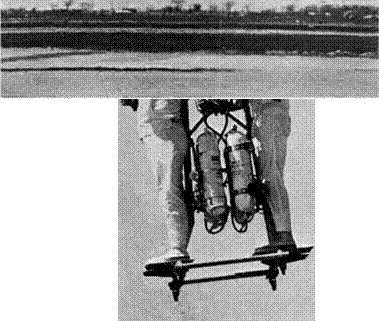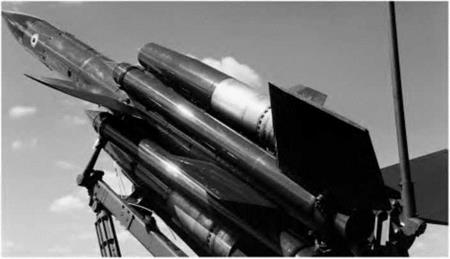Rocket propulsion
Rocket propulsion is also very straightforward in principle. As illustrated in Fig 4.3 (overleaf), in the simplest motors, fuel is burned in a combustion chamber, to create heat and a high pressure gas. The hot gases then flow out through the specially-shaped throat and outlet nozzle at high speed. The main difference between the rocket and other forms of propulsion is that air is not used as the oxidant in the burning process, and the gases that are emitted from the outlet are all derived from the fuels.
Apart from its use in some high speed research aircraft, and one highly dangerous German interceptor aircraft of Word War II (the Messerschmitt Me 163), the rocket is mainly used for missiles and spacecraft. The strange vehicle shown in Fig. 4D (overleaf), which used a rocket both for propulsion and lift, never developed into a practical means of transport.
Rocket motors come in two basic types, a solid fuel type, where the fuel and oxidiser are combined in a stable solid form, as in a simple firework, and a liquid propellant type, where two chemicals, one usually the fuel and the other a powerful oxidiser, are mixed together and burned in a combustion chamber.
|
|
Fig 4C Ramjet propulsion
The ВАС Bloodhound missile used two ramjets: the large tubular shapes with silvery ends which can be seen above and below the body. The smaller tubes are solid-fuel rockets which were used to boost the missile to high speed; they were jettisoned once the ramjets had taken over.
|
|
|

 |
Fig 4.3 Principle of rocket propulsion
Fig 4D Rocket propulsion
(By courtesy of Bell Aerospace Division of Textron Inc, USA)
Flying the two-man Pogo from the rear platform is the rocket belt operator; on the front deck is the rocket technician.
Rocket motors have a very high thrust to weight ratio, and are essentially very simple. However they use fuel and oxidiser at a very high rate, and so have relatively short duration. The need to carry oxidiser as well as fuel means that the total weight of expendable chemicals carried is much higher than in engines that use air as the oxidant. Recently, engines have been developed which use air as the oxidant at low altitudes and pure rocket propulsion at high altitudes or in space.
Apart from the simple chemically fuelled rockets, several more advanced types have been developed. These include ones in which ionised particles or plasma is accelerated to very high speeds by electrostatic or electromagnetic forces. Some of these have been used on spacecraft, normally as low-thrust control jets.












